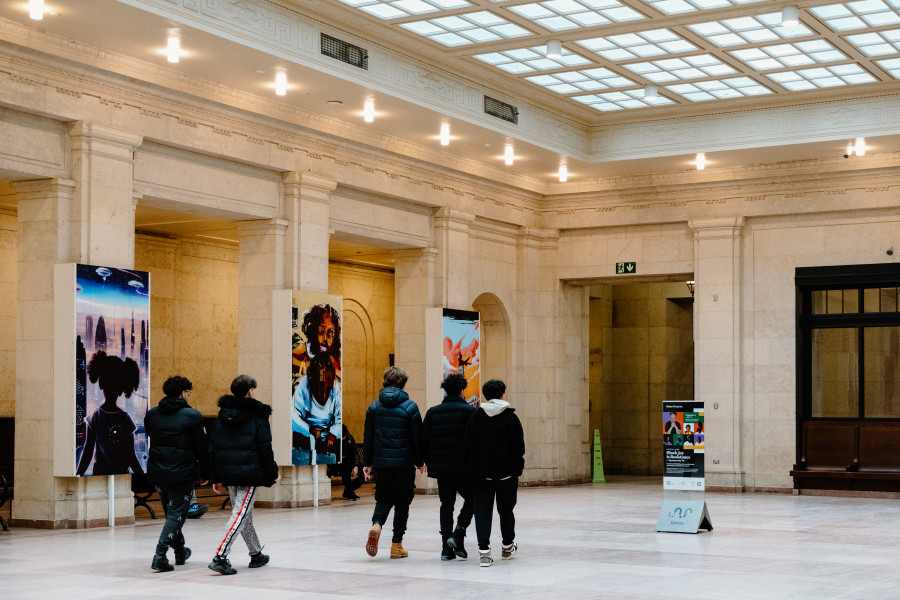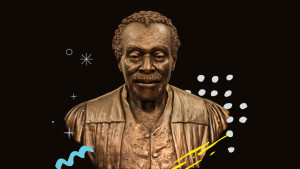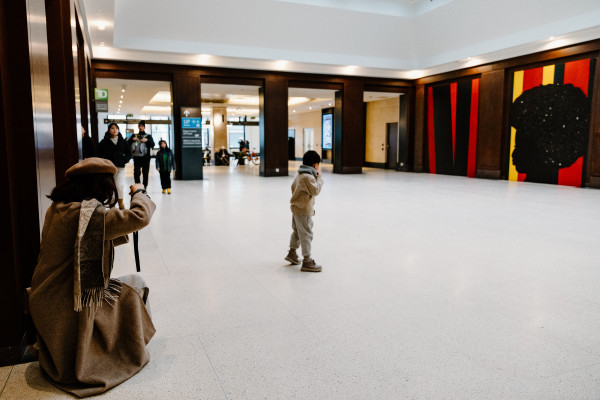The racial epithets. The continuing trauma, all of it, is overbearing. Yet, on the other side of the spectrum, the Black diaspora understands the concept of the word ‘celebration.’ It’s not just a mere act of leaving the house to attend gatherings. It’s about the sheer essence of it—the joy, revelry, jubilation and togetherness that celebrations can bring. For us, they are held dear and speak volumes about our survival.
We turn to celebrations as an act of resilience, and it dates back to our ancestors. If you’re unsure of what I’m alluding to, look up your history on Caribbean carnivals, and you’ll get the gist. But here in Toronto, walking through Union Station, the public art exhibit I Am Here: Black Joy Is Resistance, sponsored by TD, takes the concept of resilience and expresses it via AI, digital artwork, broad, colourful strokes on canvas and large, pictorial pieces for everyone to experience.
The exhibit’s premise originated from a genuine discussion curator, writer, and multi-disciplinary artist Gloria Swain had with Union Station’s executive director of programming and special events, Syma Shah and founder of arts organization MakeRoom Inc., Trevor Twells. Recollecting upon her experiences with systemic oppression and straight-up racism that has tested her time and again in the art world, Swain shared how she chose joy and love as an act of resistance to overcome and move forward.
The interpretation of Black resistance is curated by MakeRoom Inc. At the media launch and panel discussion, Twells stated, “We really wanted to get away from the tropes of sadness and mourning of Black History Month. Gloria talked about the resistance against oppressive systems. And then I asked, ‘well, is there room for joy?’ Gloria looked straight at the camera, and I thought, she’s either going to cuss me, or she’s going to blow my mind.’ Well, she ended up blowing my mind. She said, ‘Well, Black joy is resistance.’ And that’s something I still think about.”
“We thought a little deeper about it, and Black joy is real systemic change, right? A system that is meant to rob people who look like us—of that joy; to feel joy is to make change. Joy to us is community. You’ll see through the art [that] the thread is community.”
MakeRoom Inc. opened art solicitations to the community and was surprisingly flooded with over 100 submissions. Out of the 100, only six were chosen: Frantz Brent-Harris, Jibola Fagbamiye, Rae Clair, Adetona Omokanye, Danyal Barton, and Elicser Elliott, alongside veteran Gloria Swain. In the Oak Room, you will be privy to her colourful mixed-media triptych called ‘Black Hair,’ and as you move further down, the six other artists bring you into their world and perspectives of Black joy and resistance.
As I mingled and spoke to the artists about their pieces, the common thread was disbelief and gratitude. “I just can’t believe it. It still hasn’t registered. I have always dreamed of having my work in a prominent spot and expressing my individualism in my art. I really still can’t believe this opportunity has occurred, you know? I’m just so thankful,” says Danyal Barton. Everyone’s artwork speaks for itself, with allegories of the perception of Blackness around the world to a future society that embraces radical racial acceptance. It’s a beautiful thing to see.
Swain is moved by the work of the young artists. Watching, learning from and supporting them is also clearly part of her Black joy and resistance regimen. One that we’re sure she will continue doing as she continues on her artistic journey. “The resistance is me sitting here at my age after all the issues that I’ve dealt with, and I’m still pushing. And the Black joy is, to me, the young Black artists who are creating art. So that brings joy to my heart because each generation wants to see the next generation do better than them. They’re doing that, and it brings joy to my heart,” says Gloria
The I Am Here: Black Joy Is Resistance art installation runs from February 6th to May 31st at Union Station in the main corridor.

 By
By 






